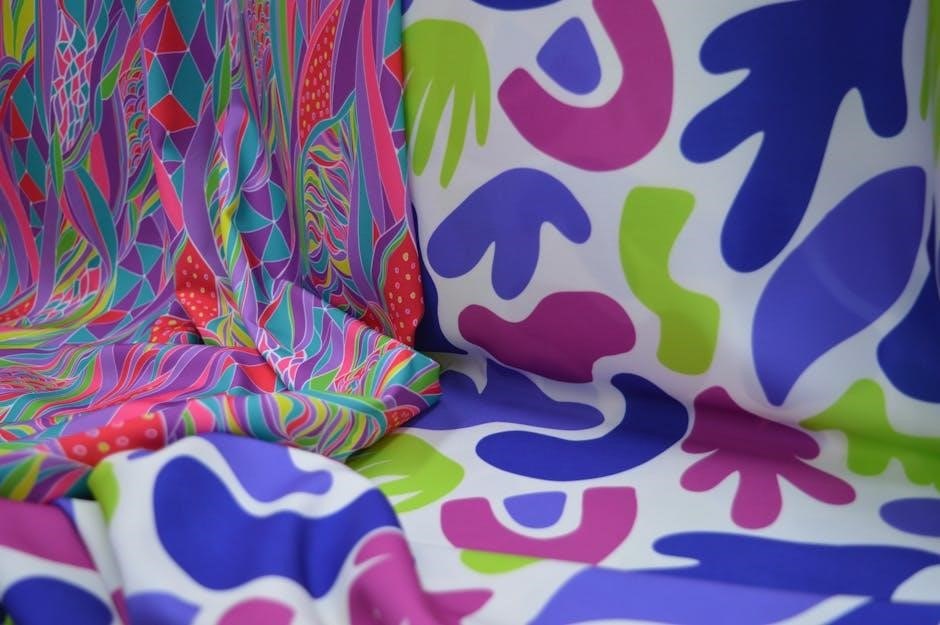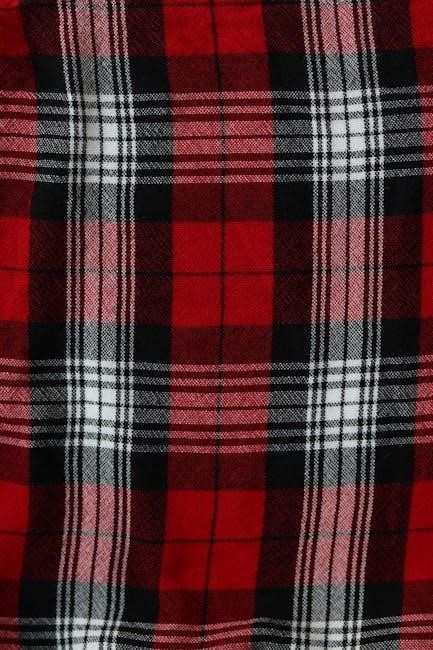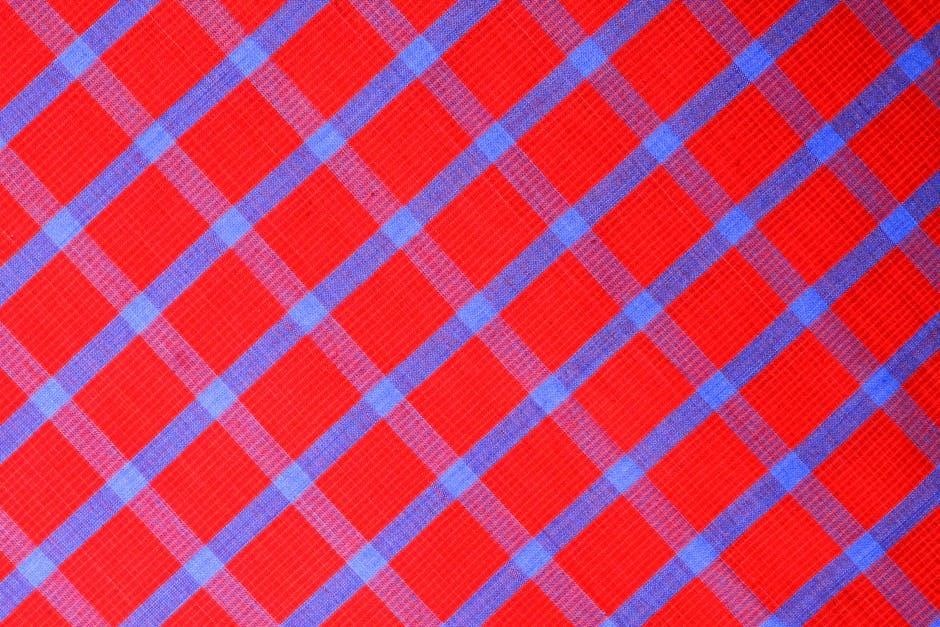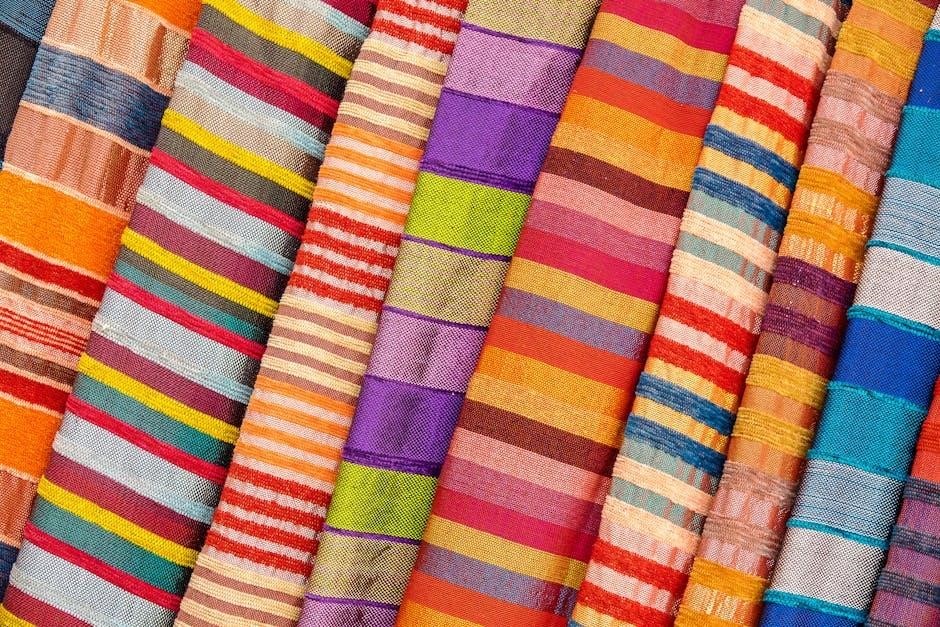Understanding PDF Sewing Patterns
PDF sewing patterns are digital templates designed for home printing on A4 or Letter-sized paper. They often include multiple sizes and are easily reusable‚ offering convenience and flexibility for sewists of all skill levels. The format allows for accurate scaling and tiling‚ ensuring precise assembly of pattern pieces. This innovative approach streamlines the sewing process‚ making it accessible and efficient for creators worldwide.
What is a PDF Sewing Pattern?
A PDF sewing pattern is a digital file containing a sewing template that can be downloaded and printed at home. It is designed to be tiled across multiple pages‚ allowing users to assemble the full-size pattern. Unlike traditional paper patterns‚ PDFs are reusable‚ cost-effective‚ and easily accessible. They often include multiple sizes‚ enabling sewists to choose their perfect fit. Many PDF patterns are designed for specific projects‚ such as clothing‚ accessories‚ or home decor. Once downloaded‚ the pattern can be printed on standard paper sizes like A4 or US Letter‚ making it convenient for home printers. This format has become popular due to its flexibility and the ability to print only the needed pieces‚ reducing waste and saving time.

Preparing to Print
Ensure your printer is set to the correct paper size and scaling options. Use test squares to verify accuracy and proper alignment before printing the full pattern.
Choosing the Right Paper Size
Selecting the correct paper size is crucial for accurate PDF sewing pattern printing. Common options include A4‚ US Letter‚ and A0 for large-format prints. Ensure your printer settings match the pattern’s specified size to avoid scaling issues. Many patterns are designed to fit standard home printer paper‚ but verify the file’s requirements before printing. Using the wrong size may result in misaligned tiles or incorrect measurements. Always check the pattern’s instructions for recommended paper sizes and adjust your printer settings accordingly to ensure a seamless sewing experience.
Printer Settings for Scaling
Correct printer settings are essential for accurate scaling when printing PDF sewing patterns. Ensure your printer is set to “Actual Size” or “100%” scaling to maintain the pattern’s true dimensions. In Adobe Acrobat‚ uncheck “Fit to Printable Area” and “Shrink Oversized Pages” to prevent unintended resizing. Select “Auto Portrait/Landscape” to allow the printer to adjust orientation based on the page content. Always print a test page‚ such as the included test square‚ to verify accuracy. If the test square measures incorrectly‚ adjust your printer settings and reprint. Proper scaling ensures that all pattern pieces fit together seamlessly‚ eliminating errors in your sewing project. Double-checking these settings saves time and material‚ guaranteeing professional results every time.
Printing the Pattern
Initiate printing by selecting “Print” in your PDF viewer‚ ensuring settings match your paper size and printer. Use test squares for accuracy and verify page orientation for proper alignment. This ensures seamless pattern assembly and precise measurements for your sewing project.
Tiling and Assembling Pages
Tiling and assembling PDF sewing patterns involve printing the design across multiple pages‚ which are then aligned and taped together. Ensure each page is printed at 100% scale to maintain accuracy. Use the grid lines or test squares provided in the pattern to verify alignment. Trim excess margins and match the edges carefully to form the complete pattern. For large patterns‚ consider organizing pages in rows and columns before taping. Apply clear tape along the edges‚ ensuring the seams and lines align perfectly. Double-check the assembled pattern for continuity in lines and measurements. This step is crucial for achieving the correct fit and shape of your finished sewing project.
Using Test Squares
Test squares are essential for ensuring accurate printing of PDF sewing patterns. These squares‚ usually 1×1 inch or 2×2 centimeters‚ are included on the first page of the pattern. Print the page at 100% scale without resizing or scaling adjustments. Measure the test square with a ruler to confirm its accuracy. If the square measures correctly‚ proceed with printing the remaining pages. If not‚ adjust your printer settings to achieve the correct scale. Accurate test squares ensure that all pattern pieces are the correct size‚ preventing fitting issues in your finished project. This step guarantees that your printed pattern is reliable and ready for assembly and sewing.

Post-Printing Steps
After printing‚ align and tape the pages together following the guide marks. Ensure accurate alignment for proper pattern assembly. Cut out the pattern pieces carefully along the lines.
Assembling the Printed Pages
To assemble the printed pages‚ start by matching the alignment markers or reference points on each page. These are usually small shapes or lines at the edges of the paper. Use a large‚ flat surface and arrange the pages in the correct order based on the pattern’s grid. Begin from the center and work outward to avoid misalignment. Secure the pages temporarily with tape before applying permanent adhesive. Ensure all edges are flush and lines connect seamlessly. Double-check the test square to confirm accuracy. Once assembled‚ the pattern is ready for cutting. Proper assembly ensures the sewing project fits correctly‚ making this step crucial for success.
Cutting Out Pattern Pieces
Cutting out pattern pieces accurately is a critical step in the sewing process. Use sharp scissors or a rotary cutter and mat for clean‚ precise cuts. Always cut along the solid lines of the pattern‚ following the grain line indicators to ensure fabric stability. For symmetrical pieces‚ fold the fabric as instructed and cut through both layers. Notches and markers should be carefully cut or punched to aid in accurate sewing alignment. Transfer all labels and symbols to the fabric using a marking tool. Double-check the pattern instructions for any specific cutting tips‚ such as handling curved edges or intricate details. Proper cutting ensures a professional finish and a well-fitting garment‚ making it essential to take your time and work carefully during this stage.
Alternative Printing Options
Explore professional printing services like Net Printer or PDF Plotting for high-quality‚ full-scale prints without tiling. These services save time and ensure accurate‚ hassle-free results.
Professional Printing Services
Professional printing services offer a convenient alternative to home printing‚ providing high-quality‚ full-scale outputs without the hassle of tiling pages. Services like Net Printer and PDF Plotting specialize in printing sewing patterns on large-format paper‚ ensuring accurate scaling and vibrant colors. These services are ideal for complex patterns or large projects‚ saving time and effort. Many providers use premium paper and advanced printers to deliver crisp‚ durable prints. Additionally‚ some services offer A0-sized prints‚ eliminating the need for assembly. They often include test squares to verify accuracy. With competitive pricing and fast turnaround times‚ professional printing services are a practical solution for sewists seeking precise‚ high-quality results without the hassle of home printing.

Resources and Troubleshooting
Access free sewing patterns and troubleshooting guides online for common printing issues. Websites offer step-by-step solutions‚ ensuring accurate scaling and assembly of PDF sewing patterns effortlessly.
Accessing Free PDF Patterns
Accessing free PDF sewing patterns is simple‚ with numerous online resources offering a wide range of designs. Websites like Scattered Thoughts of a Crafty Mom and Burdastyle provide over 120 multisized‚ printable patterns for women‚ kids‚ and accessories. These patterns are available for immediate download and include step-by-step tutorials‚ making them ideal for beginners. Many platforms also offer modern and stylish designs‚ from dresses and tops to bags and home decor. To ensure accuracy‚ test squares are often included in the first page of the pattern. This feature helps verify that the print scale is correct before assembling the full design. With these resources‚ you can start sewing without spending a dime‚ creating professional-looking garments and projects effortlessly.
Troubleshooting Common Issues
When printing PDF sewing patterns‚ common issues like incorrect scaling or misaligned pages can arise. To address these‚ ensure your printer settings are configured to Actual Size or 100% Scale to maintain accuracy. Additionally‚ using the Adobe Acrobat Reader is recommended‚ as other PDF viewers may not support necessary features. If the test square provided in the pattern does not measure correctly‚ adjust the printer settings or re-download the file. For persistent problems‚ consulting the pattern designer’s support or online forums can provide tailored solutions. Regularly updating your PDF reader and printer drivers also helps prevent technical glitches‚ ensuring a seamless printing experience for your sewing projects.

Tools for Success
Essential tools include a reliable printer‚ Adobe Acrobat Reader‚ scissors‚ tape‚ and a ruler. These ensure accurate printing‚ assembly‚ and cutting of PDF sewing patterns for precise results.
Essential Tools for Accuracy
To ensure precision when working with PDF sewing patterns‚ several tools are indispensable. A reliable printer with accurate scaling capabilities is crucial for maintaining the correct proportions of the design. Adobe Acrobat Reader is necessary for viewing and printing PDF files without distortion. A measuring tape or ruler helps verify the test squares included in most patterns‚ ensuring the print size is correct. Scissors or a craft knife are essential for cutting out the pattern pieces accurately. Additionally‚ transparent tape or a glue stick is needed for assembling the tiled pages seamlessly. A large‚ flat workspace is also recommended for spreading out and aligning the printed sheets. These tools collectively ensure that the pattern is accurately printed‚ assembled‚ and ready for use in your sewing projects.
Printing PDF sewing patterns is a convenient and flexible way to create custom garments and projects. With the right tools and settings‚ you can achieve professional results at home. Always ensure accurate scaling‚ use test squares for verification‚ and assemble pages carefully. Whether you’re a beginner or an experienced sewer‚ PDF patterns offer endless possibilities. Explore free patterns‚ invest in quality tools‚ and enjoy the satisfaction of bringing your sewing ideas to life. Happy sewing!

Leave a Reply